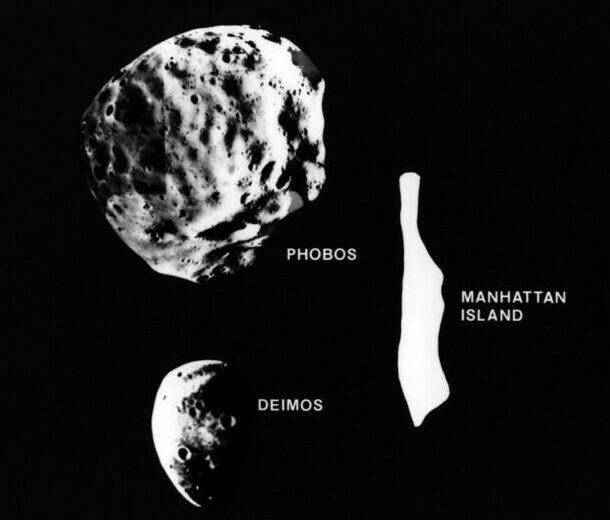Mars, being the nearest planet to us in the solar system, naturally piques our interest and curiosity. We have conducted research on Mars for hundreds of years, gaining significant knowledge, yet there remains a vast amount yet to be discovered. The fascination could stem from pure curiosity, but some scientists suggest that Mars could offer a solution for sustaining life if Earth’s natural resources were to be depleted. Today we delve into some unexpected facts about our neighboring red planet.
So without further ado let’s dive into 25 Surprising Facts About the Red Planet – Mars.

Why is it Red?
 https://www.space.com/47-mars-the-red-planet-fourth-planet-from-the-sun.html
https://www.space.com/47-mars-the-red-planet-fourth-planet-from-the-sun.html Why do we call it the Red Planet in the first place? Well, we call it that because of the reddish solid covering the majority of the surface of the planet, but why is it red?
Mars gets the red tint in its soil due to the fact that it’s rich with iron. The sheer amount of iron in the soil means that when exposed to the open air the iron minerals in the soil oxidizes and rust giving Mars its iconic reddish rusty look.
One Mars Year
 https://en.wikipedia.org/wiki/Timekeeping_on_Mars#:~:text=The%20length%20of%20time%20for,are%20not%20of%20equal%20length
https://en.wikipedia.org/wiki/Timekeeping_on_Mars#:~:text=The%20length%20of%20time%20for,are%20not%20of%20equal%20length On Earth our years clock in at a solid 365 days a year,this isn’t so on Mars however. In fact the average year on Mars is 687 days long. That’s one year and 322 days on earth. It takes just under two years for Mars to make it all the way around the sun just one time.
Because of the length of one Mars year its seasons are much different lengths than ours. Autumn and Spring are Mars’s shortest seasons at 142 days.
Mars Has A Liquid Core
 https://mars.nasa.gov/news/453/scientists-say-mars-has-a-liquid-iron-core/
https://mars.nasa.gov/news/453/scientists-say-mars-has-a-liquid-iron-core/ Unlike Earth Mars actually has a liquid core. A liquid iron core to be specific and while Earth does have liquid iron in it it’s more of an inner layer above our more solid core. We were able to determine this in the early 2000’s from a surveyor spacecraft above Mars.
They measured the planet’s gravitational pull towards the sun and from it were able to determine that its core wasn’t cool enough to be solid. They believe this has to do with the fact that Mars is a much smaller planet and therefore has a warmer internal temperature than the majority of Earth’s core.
Mars Is Very Cold
 https://www.space.com/16907-what-is-the-temperature-of-mars.html
https://www.space.com/16907-what-is-the-temperature-of-mars.html Despite looking like a desert Mars is actually quite cool. In fact the average temperature of Mars is a cool minus 80 degrees fahrenheit, or minus 60 celsius. Now this is only the average, it can get much much colder on the red planet. The lowest ever recorded temperature on Mars comes in at a brisk minus 200 degrees fahrenheit (minus 128 celsius). In comparison the lowest recorded temperature on Earth was in Antarctica and it was minus 128 fahrenheit (minus 88 celsius).
The hottest it’s ever gotten on Mars is just 70 degrees fahrenheit (56 degrees celsius) and while that sounds like a nice cool day to lounge around we certainly wouldn’t recommend it.
Mars Has Water
 https://www.space.com/mars-liquid-water-south-pole-subglacial
https://www.space.com/mars-liquid-water-south-pole-subglacial If you didn’t know Mars has a southern pole that is covered in ice caps, much like the ice caps we have at both of our poles. The biggest difference between the Mars ice caps and Earth’s ice caps is that it was believed that the ice caps on Mars were frozen all the way through while Earth’s ice caps tend to have waterways and lakes underneath them.
However recent research has suggested that under a very thick layer of ice there may actually be some waterways. This would mean that Mars is still geothermically active and has a source of warmth.
Mars Has a Much Thinner Atmosphere
 https://www.space.com/16903-mars-atmosphere-climate-weather.html
https://www.space.com/16903-mars-atmosphere-climate-weather.html By Earth standards Mars has a very thin atmosphere. How thin? Well it’s almost 100 times thinner than Earth’s atmosphere and while our atmosphere is made up mostly of Nitrogen and Oxygen (72% and 21% respectively) Mars’ atmosphere is almost entirely made up of Carbon Dioxide. In fact the atmosphere of Mars is made up of nearly 96% Carbon Dioxide and it has absolutely 0 Oxygen.
Mars Could Fit inside of Earth 6 Times
 https://www.universetoday.com/22603/mars-compared-to-earth/
https://www.universetoday.com/22603/mars-compared-to-earth/ Earth’s volume is equivalent to 1,083 billion cubic kilometers, in comparison Mars is only 163 billion cubic kilometers. That’s just 15% of earth’s volume. This means that if you wanted to fill earth with Mars you could fit just over 6 Mars’ snugly inside of Earth. Not that you’d wanna do that. Pretty sure that would destroy our planet.
The First People to Study Mars
 https://www.space.com/47-mars-the-red-planet-fourth-planet-from-the-sun.html
https://www.space.com/47-mars-the-red-planet-fourth-planet-from-the-sun.html You may recognize the name of the first person to have viewed Mars with a telescope, as it was famed scientist Galileo Galilei all the way back in 1610. In the century that followed Galileo’s studies, astronomers discovered the planet’s polar ice caps and in the 19th and 20th centuries some researchers believed they saw a network of long, straight canals on the surface of Mars. At the time they believed this to be a sign of civilization on the planet but we now know that this was simply a misinterpretation of geological features.
Why Is It Named Mars?
 https://www.space.com/47-mars-the-red-planet-fourth-planet-from-the-sun.html
https://www.space.com/47-mars-the-red-planet-fourth-planet-from-the-sun.html Mars has had many names to many different civilizations. Mars comes from the Roman god of war. Likewise the Greeks named it Ares, their god of war. Other civilizations have typically named it after its reddish hue. The Egyptians called it “Her Desher” which means “the red one” and ancient Chinese astronomers named it “the fire star” which is much cooler than “the red one”.
While we have collectively chosen Mars as its official name, everyone also calls it The Red Planet.
Mars’ Two Moons
 https://www.space.com/47-mars-the-red-planet-fourth-planet-from-the-sun.html
https://www.space.com/47-mars-the-red-planet-fourth-planet-from-the-sun.html Mars has two moons; they were discovered by an astronomer named Asaph Hall in 1877 over the course of one week. They were named Phobos and Deimos after the sons of the Greek god of war Ares.
Phobos and Deimos, unlike our moon, aren’t spherical in nature. They have much more abnormal shapes. This is believed to be because their gravitational pull isn’t strong enough to form a more spherical figure or because the moons are actually just captured asteroids rather than the traditional moon.
Phobos and Deimos are Very Small
 https://www.space.com/47-mars-the-red-planet-fourth-planet-from-the-sun.html
https://www.space.com/47-mars-the-red-planet-fourth-planet-from-the-sun.html Much like the planet they rotate, Mars’ moons Phobos and Deimos are very small compared to our moon. Phobos is the larger of the two moons at 17 miles wide and is largely covered by a massive crater that encompasses 6 of those 17 miles. Deimos is only 9 miles wide by comparison and is also pockmarked with craters.
In comparison, our moon is well over 2,000 miles wide. So while Mars may have more moons than us, our moon is still bigger than both of Mars’ moons combined. Take that Mars.
Phobos’ Fate
 https://www.space.com/47-mars-the-red-planet-fourth-planet-from-the-sun.html
https://www.space.com/47-mars-the-red-planet-fourth-planet-from-the-sun.html According to the astronomy community, Phobos is very slowly spiraling towards the surface of Mars. They believe that Phobos will one day cease to exist and they think one of two things will happen to it. They believe that Phobos will one day either crash into the surface of Mars and make a sizable crater or they believe that Phobos will break up in Mars’ atmosphere and form a ring around Mars much like the ones around Saturn.
Now this is believed to happen sometime within the next 50 million years so it’s very unlikely that we will be alive to see this occur.
Mars Robots
 https://www.space.com/47-mars-the-red-planet-fourth-planet-from-the-sun.html
https://www.space.com/47-mars-the-red-planet-fourth-planet-from-the-sun.html The sheer amount of devices we’ve sent as a species to observe and research Mars is staggering. We’ve been sending rovers, orbital devices, miniature helicopters, and landers to Mars since the early 60’s and we’re still sending more and more even today. The most recent of which was an orbiter and a rover from China called Tianwen 1. It reached orbit and landed in February of 2021 and was China’s first full expedition to Mars.
There’s also a multi-part European led rover program designed to observe Mars from the ground and from orbit in development as we speak but it’s been delayed several times and likely won’t launch until at least 2028.
Mars Has a Low Gravitational Pull
 https://mars.nasa.gov/all-about-mars/facts/
https://mars.nasa.gov/all-about-mars/facts/ Mars’ gravitational pull is far lesser than Earth’s gravitational pull, in fact if you were on Mars you would experience 62% less gravity than you would on Earth. You could bounce and bound around with every step. This also means that you would weigh a lot less than you do on Earth. If a person weighed 100 lbs on earth it means that they would weigh just 38 lbs on Mars.
Mars, proving that weight really is just a number.
Mars’ Axis Means Many Different Climates
 https://www.space.com/47-mars-the-red-planet-fourth-planet-from-the-sun.html
https://www.space.com/47-mars-the-red-planet-fourth-planet-from-the-sun.html Like we said previously, Mars’ moons aren’t very large, because of this Mars’ axis isn’t stabilized like our large moon does for us. Mars’ axis swings wildly over time and has led to many different climates on Mars’ surface over its history. A 2017 study revealed that because of this shifting tilt in Mars’ axis, it at one point released methane gas into the atmosphere which warmed the planet’s surface which allowed water to flow on the surface, which in turn created the valleys we study today.
Mars Has the Biggest Dust Storms
 https://www.space.com/47-mars-the-red-planet-fourth-planet-from-the-sun.html
https://www.space.com/47-mars-the-red-planet-fourth-planet-from-the-sun.html You may think you know dust storms, but by martian standards you haven’t seen anything. The dust storms on Mars are the largest dust storms in the entire solar system. These storms are capable of covering the entirety of the Red Planet’s surface and can last anywhere from weeks to months.
We believe this to be because the dust particles in the air absorb sunlight which warms the Martian atmosphere. These warm pockets of air then flow toward colder regions which generate winds. The strong winds lift more dust off the ground, which, in turn, heats the atmosphere, raising more wind and kicking up more dust.
In fact it was because of these winds that Mars Rover Opportunity died, it was consumed in a giant dust storm that blocked out the sun meaning the rovers solar panels were denied sunlight for weeks.
Mars has the Tallest Mountains and the Longest Valleys
 https://www.space.com/47-mars-the-red-planet-fourth-planet-from-the-sun.html
https://www.space.com/47-mars-the-red-planet-fourth-planet-from-the-sun.html Mars has the tallest and largest mountain in the entire solar system. Olympus Mons is 17 miles high and to put that into perspective Earth’s tallest mountain, Mount Everest, is just over 5 miles high. Which means Olympus Mons is three times as tall as our tallest mountain.
Not only that but the longest valley on Mars is Valles Marineris which is a system of valleys that is 6 miles deep and runs east-west for around 2,500 miles which is nearly one-fifth of the distance around Mars which makes it the Longest valley in the entire solar system.
Mars Has The Biggest Volcanoes
 https://www.space.com/47-mars-the-red-planet-fourth-planet-from-the-sun.html
https://www.space.com/47-mars-the-red-planet-fourth-planet-from-the-sun.html Not only does it have the largest mountains but it has the largest volcanoes too. Olympus Mons is one of these volcanoes but it isn’t the largest. The largest volcano on Mars is a massive 370 miles in diameter which would cover up the entirety of the state of new mexico.
In fact a lot of the surface of Mars is covered in hardened volcanic material and it’s even believed that these volcanoes may still have minor eruptions to this day.
Mars’ Magnetic Field
 https://www.space.com/47-mars-the-red-planet-fourth-planet-from-the-sun.html
https://www.space.com/47-mars-the-red-planet-fourth-planet-from-the-sun.html The magnetic field of a planet is what protects a planet from the sun’s cosmic radiation which means it’s very important to properly sustain life. From the research we’ve done on Mars we’ve been able to determine that Mars did have a global magnetic field at one point but that it lost most of its magnetic field over 4 billion years ago.
This led to the destruction of most of Mars’ atmosphere by solar winds. It stripped away so much of what was there leading to Mars’ now much thinner atmosphere. That being said, there are still parts of Mars’ surface where the magnetic field is more than 10 times as strong as the magnetic field on Earth.
Marsquakes
 https://www.jpl.nasa.gov/edu/news/2023/1/3/how-insight-revealed-the-heart-of-mars/
https://www.jpl.nasa.gov/edu/news/2023/1/3/how-insight-revealed-the-heart-of-mars/ Just like here on Earth, Mars has tectonic plates that often shift. We call them earthquakes so it’s only fitting that we call earthquakes on Mars, you guessed it, marsquakes. We’ve actually been able to discern a lot about Mars as a planet based on these marsquakes. The InSight lander was the primary machine used by NASA to study the seismic activity of the planet. It uses an instrument called SEIS, which is a seismometer, to measure marsquakes; it can also determine if the seismic activity is caused by the shifting of the plant’s tectonic plates or a meteor.
We’ve been able to gather a significant amount of information about Mars’ make-up from these marsquakes including how big the planet is, what it’s made of, and the contents of the planet’s core. InSights mission ended in December of 2022.Thanks InSight!
Mars Has Seasonal Weather
 https://www.space.com/47-mars-the-red-planet-fourth-planet-from-the-sun.html
https://www.space.com/47-mars-the-red-planet-fourth-planet-from-the-sun.html Mars, much like Earth, has a tilted axis in relation to the sun. This means that like Earth different parts of Mars experience varying amounts of sunlight throughout its year; this means it has seasons much like Earth. However, unlike Earth, Mars’ seasons tend to be a bit more extreme due to its oval-like orbit around the sun. Its orbit is also more elongated than any other major planet in our solar system.
Meaning that when Mars is closest to the sun, its southern hemisphere is tilted toward our star which gives the planet a short, warm summer, while the northern hemisphere experiences a short, cold winter. When Mars is farthest from the sun, the northern hemisphere is tilted toward the sun, giving it a longer, though not as warm summer, while the southern hemisphere experiences a longer and colder winter.
Mars Has No Signs of Civilization
 https://www.space.com/47-mars-the-red-planet-fourth-planet-from-the-sun.html
https://www.space.com/47-mars-the-red-planet-fourth-planet-from-the-sun.html Despite the possible evidence of life on Mars and the significant evidence of waterways and ocean systems, all of the research we’ve done on the planet has shown absolutely zero evidence of any sort of civilization ever having been on Mars. In fact as early as the 60’s we’ve been trying to see if there was any sign of civilization.
Now we’ve only mapped out about 80% of Mars’ surface so there’s always the possibility of finding some new evidence, but it isn’t very likely. It’s very possible that the first form of civilization on Mars will be humans ourselves.
Manned Mission to Mars
 https://www.space.com/47-mars-the-red-planet-fourth-planet-from-the-sun.html
https://www.space.com/47-mars-the-red-planet-fourth-planet-from-the-sun.html While we’ve had numerous successful robotic missions to Mars, a manned mission still poses many challenges, the biggest of which is how long it would take to get there. Right now it would take a manned mission to Mars at least 6 months just to make it to the planet which would mean significant exposure to deep space radiation and microgravity, both of which have devastating effects on the human body. This would make it very difficult for extensive research to be done on the planet’s surface.
Despite all this, there is an active effort to make a manned mission to Mars. The biggest of which is a NASA-led expedition that could be possible as soon as 2030. China, Russia, and other nations have also made clear their aspirations of sending humans to Mars in the coming decades.
Mars Rocks
 https://www.space.com/47-mars-the-red-planet-fourth-planet-from-the-sun.html
https://www.space.com/47-mars-the-red-planet-fourth-planet-from-the-sun.html No, we’re not just saying that Mars is cool – I mean it is, but that’s not the point. We’re talking about actual rocks that have fallen to Earth all the way from Mars. There have only been a select few that have made it all the way here but when they do it gives scientists a rare opportunity to research Mars’ surface from the comfort of their own labs. Likely some of the most controversial research done on these rocks was done in 1996 on a martian meteorite. The research claimed that they had found tiny fossils and more evidence of life on Mars.
While their research and theory is still heavily debated, the entirety of the 1996 research team still believes in their conclusion to this day.
History of Mars
 https://www.space.com/47-mars-the-red-planet-fourth-planet-from-the-sun.html
https://www.space.com/47-mars-the-red-planet-fourth-planet-from-the-sun.html Being the closest planet to us we’re obviously interested in it so as a species we’ve done tons of research on the planet and its history. From the research we’ve gathered over the years, we’ve managed to discern that at one point Mars had flowing water and oceans, it once had a much thicker atmosphere, more akin to Earth’s, and it was at one point a completely habitable planet by human standards. So lots of our questions have been answered but they’ve made way for more questions, the biggest of which being, what happened to make it uninhabitable?
We may never know.
If you enjoy reading about planets, check this list of 25 Incredible Planets We Could Live On Someday.
Lists Going Viral Right Now
"Mars Visualization with Satellite Imagery Overlay" by Kevin M. Gill is licensed under CC BY 2.0 .



























